
& treatment plans: best practice

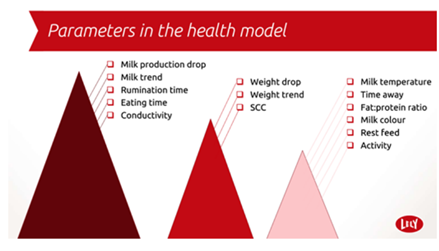


The "NEW" icon means:
The sick chance in the last 14 days is lower than the threshold you set
(excluding the last 24 hours).The cow is not currently receiving treatment.
Good to know
The model corrects for DIM: animals < 60 DIM get more attention.
The model corrects for cows in heat or with an insemination event.
Youngstock and dry cows miss astronaut data but they are included in the health task.
Health task/Report Parameters
To avoid false alarms, we correct the values for herd-wide changes in milk drop, temperature, and eating time caused by for instance hoof trimming, going to pasture or other herd events.
The parameters used in the health report are, depending on robot equipment:
Milk Drop (Kg) (standard)
Weight Trend and Total Weight Loss (optional)
Activity & Inactivity (optional)
Acute Inactivity (optional)
Conductivity (standard)
Chronic Conductivity (standard)
Temperature (standard)
Time Away (standard)
SCC (Somatic Cell Count) Indication (optional)
Fat to Protein Ratio (standard)
MQC (Milk Quality Control) color: Watery, Mastitis, Blood, Abnormal (standard)
Milk Trend (standard)
Feed Rest Percentage (standard)
Rumination time (optional)
Eating time (optional)
Think of it as a red flag when a cow needs attention. We recommend checking this task twice daily as part of the daily routine. The strength of this task lies in the combination of data to base decisions on. Therefore, it is not recommended to base the diagnosis of sick cows on the output of one parameter.
How to use the Health task
The health task displays a list of cows that exceed the default sick chance threshold, with the cows that need the most attention on top of the list. The sick chance indicates how likely a cow is to be sick ranging from 0 to 99%.
If a cow has already been assigned to a health treatment, a first-aid icon is visible. The arrows in the sick chance bar means:
Up arrow (5% increase): The cow's sick chance is 5% higher than the highest in the past 24 hours.
Down arrow (5% decrease): The cow's sick chance is 5% below the average of the past 24 hours.
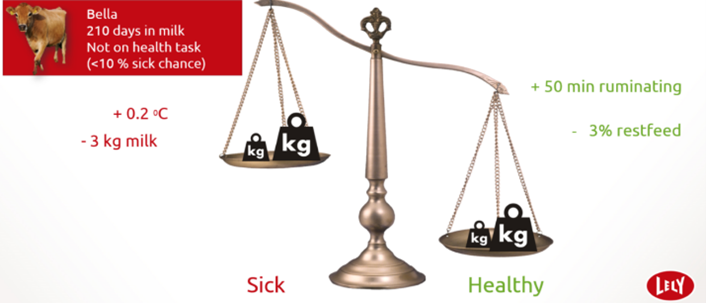
March 2024
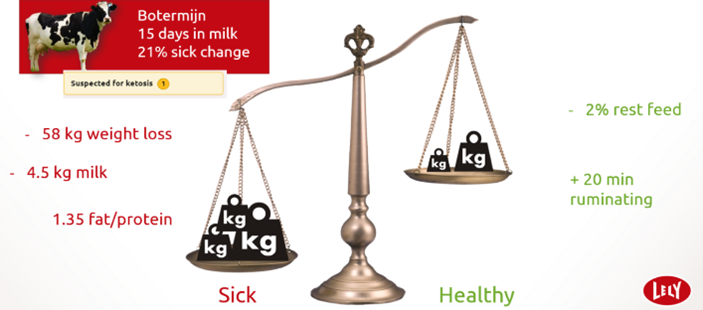
Health task shows deviating parameters and the severity of that deviation, for instance inactivity, EC and milk drop. Meaning that when more parameters are measured the accuracy of the sick chance increases. Animals with a certain sick change can be routed to the routing area, based on farm specific needs. This makes the cow easy to find and check.
The health task is a balance, one indicator can be negative, but that does not mean that the sick chance is high:
Cow health is continuously monitored with data via the Lely Astronaut and other responders. This data is shown in Lely Horizon. Historical data and realtime data are used to calculate a sick chance. The health task will show the animal with a sick change higher than set threshold (10 by default). Meaning that only cows that need attention will be shown.
health task
the numbers explained
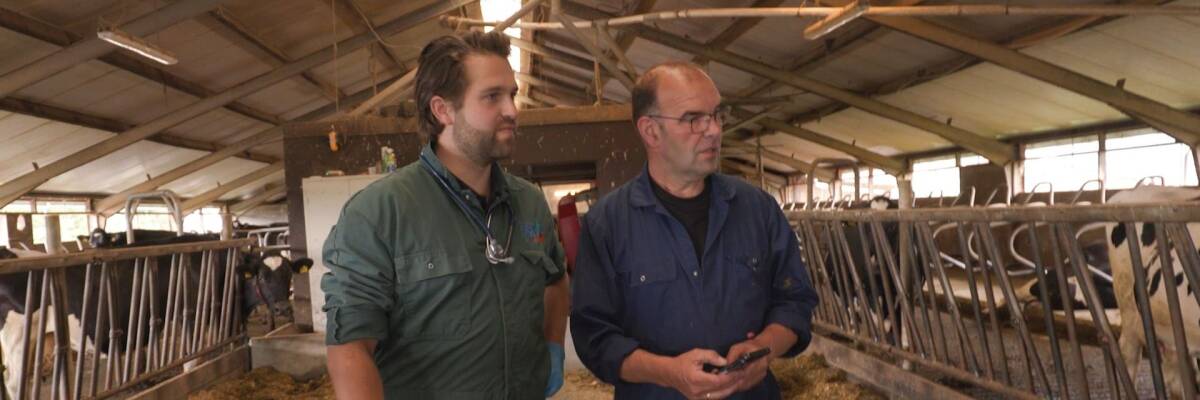


The "NEW" icon means:
The sick chance in the last 14 days is lower than the threshold you set
(excluding the last 24 hours).The cow is not currently receiving treatment.
Good to know
The model corrects for DIM: animals < 60 DIM get more attention.
The model corrects for cows in heat or with an insemination event.
Youngstock and dry cows miss astronaut data but they are included in the health task.
Health task/Report Parameters
To avoid false alarms, we correct the values for herd-wide changes in milk drop, temperature, and eating time caused by for instance hoof trimming, going to pasture or other herd events.
The parameters used in the health report are, depending on robot equipment:
Milk Drop (Kg) (standard)
Weight Trend and Total Weight Loss (optional)
Activity & Inactivity (optional)
Acute Inactivity (optional)
Conductivity (standard)
Chronic Conductivity (standard)
Temperature (standard)
Time Away (standard)
SCC (Somatic Cell Count) Indication (optional)
Fat to Protein Ratio (standard)
MQC (Milk Quality Control) color: Watery, Mastitis, Blood, Abnormal (standard)
Milk Trend (standard)
Feed Rest Percentage (standard)
Rumination time (optional)
Eating time (optional)

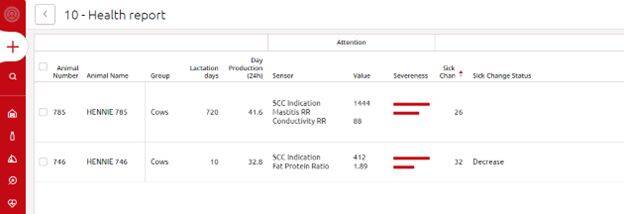
Think of it as a red flag when a cow needs attention. We recommend checking this task twice daily as part of the daily routine. The strength of this task lies in the combination of data to base decisions on. Therefore, it is not recommended to base the diagnosis of sick cows on the output of one parameter.
How to use the Health task
The health task displays a list of cows that exceed the default sick chance threshold, with the cows that need the most attention on top of the list. The sick chance indicates how likely a cow is to be sick ranging from 0 to 99%.
If a cow has already been assigned to a health treatment, a first-aid icon is visible. The arrows in the sick chance bar means:
Up arrow (5% increase): The cow's sick chance is 5% higher than the highest in the past 24 hours.
Down arrow (5% decrease): The cow's sick chance is 5% below the average of the past 24 hours.
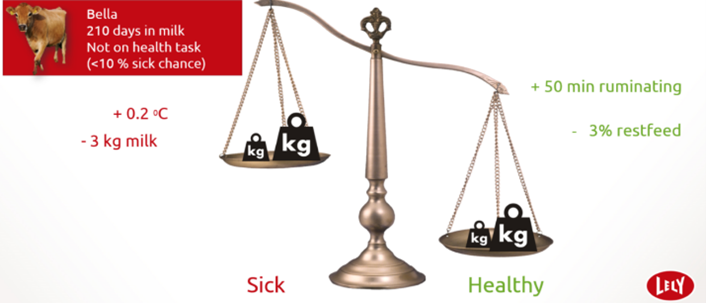
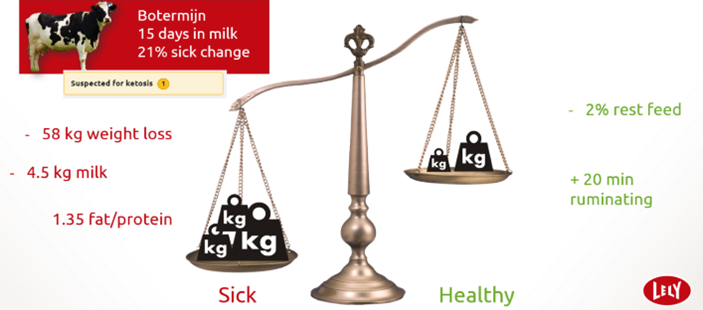
Health task shows deviating parameters and the severity of that deviation, for instance inactivity, EC and milk drop. Meaning that when more parameters are measured the accuracy of the sick chance increases. Animals with a certain sick change can be routed to the routing area, based on farm specific needs. This makes the cow easy to find and check.
The health task is a balance, one indicator can be negative, but that does not mean that the sick chance is high:
Cow health is continuously monitored with data via the Lely Astronaut and other responders. This data is shown in Lely Horizon. Historical data and realtime data are used to calculate a sick chance. The health task will show the animal with a sick change higher than set threshold (10 by default). Meaning that only cows that need attention will be shown.
health task
March 2024